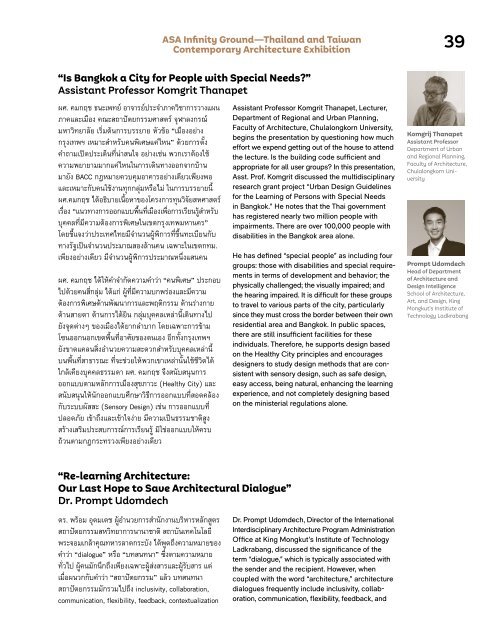ASA JOURNAL 14/2023
Create successful ePaper yourself
Turn your PDF publications into a flip-book with our unique Google optimized e-Paper software.
ผศ. คมกฤช ธนะเพทย์ อาจารย์ประจำาภาควิชาการวางแผน<br />
ภาคและเมือง คณะสถาปัตยกรรมศาสตร์ จุฬาลงกรณ์<br />
มหาวิทยาลัย เริ่มต้นการบรรยาย หัวข้อ “เมืองอย่าง<br />
กรุงเทพฯ เหมาะสำาหรับคนพิเศษแค่ไหน” ด้วยการตั้ง<br />
คำาถามเปิดประเด็นที่น่าสนใจ อย่างเช่น พวกเราต้องใช้<br />
ความพยายามมากแค่ไหนในการเดินทางออกจากบ้าน<br />
มายัง BACC กฎหมายควบคุมอาคารอย่างเดียวเพียงพอ<br />
และเหมาะกับคนใช้งานทุกกลุ่มหรือไม่ ในการบรรยายนี้<br />
ผศ.คมกฤช ได้อธิบายเนื้อหาของโครงการทุนวิจัยสหศาสตร์<br />
เรื่อง “แนวทางการออกแบบพื้นที่เมืองเพื่อการเรียนรู้สำ าหรับ<br />
บุคคลที่มีความต้องการพิเศษในเขตกรุงเทพมหานคร”<br />
โดยชี้แจงว่าประเทศไทยมีจำานวนผู้พิการที่ขึ้นทะเบียนกับ<br />
ทางรัฐเป็นจำานวนประมาณสองล้านคน เฉพาะในเขตกทม.<br />
เพียงอย่างเดียว มีจำานวนผู้พิการประมาณหนึ่งแสนคน<br />
ผศ. คมกฤช ได้ให้คำาจำากัดความคำาว่า “คนพิเศษ” ประกอบ<br />
ไปด้วยคนสี่กลุ่ม ได้แก่ ผู้ที่มีความบกพร่องและมีความ<br />
ต้องการพิเศษด้านพัฒนาการและพฤติกรรม ด้านร่างกาย<br />
ด้านสายตา ด้านการได้ยิน กลุ่มบุคคลเหล่านี้เดินทางไป<br />
ยังจุดต่างๆ ของเมืองได้ยากลำาบาก โดยเฉพาะการข้าม<br />
โซนออกนอกเขตพื้นที่อาศัยของตนเอง อีกทั้งกรุงเทพฯ<br />
ยังขาดแคลนสิ่งอำานวยความสะดวกสำาหรับบุคคลเหล่านี้<br />
บนพื้นที่สาธารณะ ที่จะช่วยให้พวกเขาเหล่านั้นใช้ชีวิตได้<br />
ใกล้เคียงบุคคลธรรมดา ผศ. คมกฤช จึงสนับสนุนการ<br />
ออกแบบตามหลักการเมืองสุขภาวะ (Healthy City) และ<br />
สนับสนุนให้นักออกแบบศึกษาวิธีการออกแบบที่สอดคล้อง<br />
กับระบบผัสสะ (Sensory Design) เช่น การออกแบบที่<br />
ปลอดภัย เข้าถึงและเข้าใจง่าย มีความเป็นธรรมชาติสูง<br />
สร้างเสริมประสบการณ์การเรียนรู้ มิใช่ออกแบบให้ครบ<br />
ถ้วนตามกฎกระทรวงเพียงอย่างเดียว<br />
<strong>ASA</strong> Infinity Ground—Thailand and Taiwan<br />
Contemporary Architecture Exhibition<br />
“Is Bangkok a City for People with Special Needs?”<br />
Assistant Professor Komgrit Thanapet<br />
Assistant Professor Komgrit Thanapet, Lecturer,<br />
Department of Regional and Urban Planning,<br />
Faculty of Architecture, Chulalongkorn University,<br />
begins the presentation by questioning how much<br />
effort we expend getting out of the house to attend<br />
the lecture. Is the building code sufficient and<br />
appropriate for all user groups? In this presentation,<br />
Asst. Prof. Komgrit discussed the multidisciplinary<br />
research grant project “Urban Design Guidelines<br />
for the Learning of Persons with Special Needs<br />
in Bangkok.” He notes that the Thai government<br />
has registered nearly two million people with<br />
impairments. There are over 100,000 people with<br />
disabilities in the Bangkok area alone.<br />
He has defined “special people” as including four<br />
groups: those with disabilities and special requirements<br />
in terms of development and behavior; the<br />
physically challenged; the visually impaired; and<br />
the hearing impaired. It is difficult for these groups<br />
to travel to various parts of the city, particularly<br />
since they must cross the border between their own<br />
residential area and Bangkok. In public spaces,<br />
there are still insufficient facilities for these<br />
individuals. Therefore, he supports design based<br />
on the Healthy City principles and encourages<br />
designers to study design methods that are consistent<br />
with sensory design, such as safe design,<br />
easy access, being natural, enhancing the learning<br />
experience, and not completely designing based<br />
on the ministerial regulations alone.<br />
39<br />
Komgrij Thanapet<br />
Assistant Professor<br />
Department of Urban<br />
and Regional Planning,<br />
Faculty of Architecture,<br />
Chulalongkorn University<br />
Prompt Udomdech<br />
Head of Department<br />
of Architecture and<br />
Design Intelligence<br />
School of Architecture,<br />
Art, and Design, King<br />
Mongkut’s Institute of<br />
Technology Ladkrabang<br />
“Re-learning Architecture:<br />
Our Last Hope to Save Architectural Dialogue”<br />
Dr. Prompt Udomdech<br />
ดร. พร้อม อุดมเดช ผู้อำานวยการสำานักงานบริหารหลักสูตร<br />
สถาปัตยกรรมสหวิทยาการนานาชาติ สถาบันเทคโนโลยี<br />
พระจอมเกล้าคุณทหารลาดกระบัง ได้พูดถึงความหมายของ<br />
คำาว่า “dialogue” หรือ “บทสนทนา” ซึ่งตามความหมาย<br />
ทั่วไป ผู้คนมักนึกถึงเพียงเฉพาะผู้ส่งสารและผู้รับสาร แต่<br />
เมื่อผนวกกับคำาว่า “สถาปัตยกรรม” แล้ว บทสนทนา<br />
สถาปัตยกรรมมักรวมไปถึง inclusivity, collaboration,<br />
communication, flexibility, feedback, contextualization<br />
Dr. Prompt Udomdech, Director of the International<br />
Interdisciplinary Architecture Program Administration<br />
Office at King Mongkut’s Institute of Technology<br />
Ladkrabang, discussed the significance of the<br />
term “dialogue,” which is typically associated with<br />
the sender and the recipient. However, when<br />
coupled with the word “architecture,” architecture<br />
dialogues frequently include inclusivity, collaboration,<br />
communication, flexibility, feedback, and


















